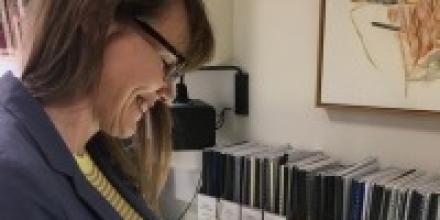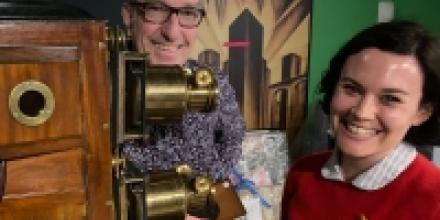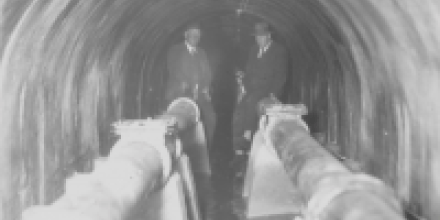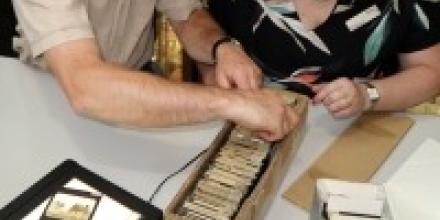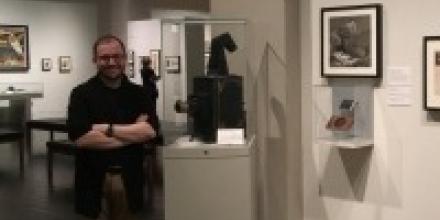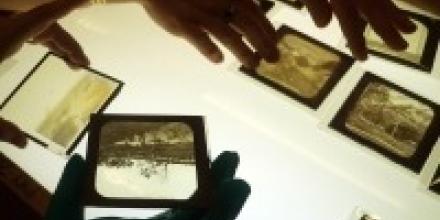Archive in the Spotlight
Archive in the Spotlight is an initiative where one of the team investigates a lantern slide series held in a public or personal collection around Australia. This process involves research into the series and, on occasion, an interview with a curator, librarian, or private custodian.
Big data and deep histories at Melbourne University’s, Visual Cultures Resource Centre
First of all, the stats: 250,000 slides and photographs of artworks; 89,000 digital records; 27,000 high resolution digital images some scanned from some of those aforementioned quarter of a million slides and photographs; 15,000 books and periodical; 1700 films — and so it goes. Each copied artwork is catalogued from the level of its country of origin down to the level of its individual iconography within the Harvard University Fogg Art Museum Classification System. But not only is there a ‘big data’ scale to the collection of the University of Melbourne’s Visual Cultures Resource…
The magic lantern in pride of place for ACMI’s 2020 Reopening
In September 2019, Chief Investigator Martyn Jolly visited the Australian Centre for the Moving Image (ACMI) to continue an ongoing collaboration between Heritage in the Limelight and its curators and staff. ACMI are currently busy developing their new permanent exhibition which, when they reopen in late April 2020, will replace their well-known and much loved ‘Screen Worlds’ display. As contemporary media forms continue to expand beyond the previously all-dominating categories of ‘the movies’ or ‘television’, ACMI’s commitment to broader optical technologies has also expanded. The new ‘…
Conjuring Canberra forth: one magic lantern show at a time
Shane Breynard, Director at Canberra Museum and Gallery, and a commencing ANU doctoral candidate in History, recently viewed an important collection of 453 magic lantern slides held in the National Library of Australia. An extensive and compelling photographic archive created by William James (Jack) Mildenhall between 1921 and 1935 records the early development and community of the national capital. The archive is made up of over 7700 black and white glass plate negatives and is held at the National Archives of Australia.1 Smaller selections of images from this archive…
Tasmanian heritage, global trade and Old World nostalgia at Narryna House, Hobart
Narryna sits on the headland that overlooks the Salamanca Place and the Derwent, which was Hobart’s Harbour. Built in 1835-40, it was initially the home of the merchant trader, Captain Andrew Haig who established the warehouses on the docks. Haig was a charismatic entrepreneur. His personal narrative tracked through the channels of the Chinese export trade from Calcutta to Canton, to Hobart and onto Chile, before he came to Hobart. His circuitous route to Tasmania, and his temporary settlement there, highlights just how interconnected Australia’s southern-most colony was to global networks of…
Whole Histories at St Clements, NSW
For many years Cheryl Mongan has been closely involved, along with the other St Clement’s Historians Drs Richard Reid, Jeff Brownrigg and Geoffrey Burkhardt, in preserving the cultural heritage of St Clement’s. As the fascinating museum which Cheryl helped create at the Retreat reveals, St Clement’s began as the property of the Irish squatter Edward ‘Ned’ Ryan. Ned had been transported from Ireland for political rebellion in 1816, receiving his Certificate of Freedom 1830 which is displayed in the museum. His son John Nagle Ryan became a Member of Parliament, and on his death, with no issue,…
‘Tasmania’s Wonderful West’, the photographic slide show and environmental activism at the Queen Victoria Museum and Art Gallery, Launceston
QVMAG collection is internationally significant for another reason: it documents a long continuity of vibrant and politically important lecturing and audio-visual projection practice about Australia’s environment. Going back to the nineteenth century, Tasmania, with its extensive wilderness areas and its history of political fights over the conservation of those areas, has been the prime generator not only of Australia’s tradition of nation-defining landscape photography, but also of Australia’s nationwide green consciousness.
Evidence of an exasperated projectionist found at Kyogle!
It was a pleasure to visit Stuart Everett’s 'Fairymount Flicks Cinema Museum', which is situated at the Kyogle Cinemas in Northern New South Wales. Unfortunately Stuart Everett passed away in 2015, but the flame is kept burning brightly by his son, Peter Everett, who along with his brother, Bruce, and sister, Helen, maintains the museum’s collection. Besides being a cattle breeder, surfer, sailor and motor sport champion, Stuart Everett was also a cinema enthusiast and a collector of early cinema technology, particularly projectors. In 1999 he opened his own cinemas at Kyogle, and a year…
Minstrels, magic lanterns and magicians: the rise and dispersion of American Vaudeville
Research Fellow, Dr Elisa deCourcy recently spent a few weeks at the Harry Ransom Center, a world-class archive of European and American visual and literary culture at the University of Texas, Austin. The Center is currently showing a landmark exhibition about the rise, character and metamorphosis of Vaudeville on the American entertaining landscape. The exhibition draws from 32 different collections across the Ransom Archive. Lead curator, Dr Eric Colleary generously set aside an afternoon to explain the logic of the exhibition and to swap notes about the magic lantern’s place in…
The power of the ‘miscellaneous’ and the skies of Queensland
Lead CI Martyn Jolly recently visited the State Library of Queensland to explore their lantern slide collection with Collection Building Librarian Reuben Hillier, conservator Kelly Leahey, and Senior Conservator Rachel Spano. Like many libraries, the SLQ has a wide range of lantern slides awaiting further research, many of which have entered the collection as part of larger acquisitions of diverse manuscript material from families or organisations. Sets that are already available for viewing online include a set of slides documenting Brisbane in the mid 1890s from the Bartlett Family; a…
A magic lantern trove: Toverlantaarn Museum
Recently, Lead CI Martyn Jolly and colleague David Wills had the rare privilege of visiting Toverlantaarnmuseum Scheveningen in The Hague, owned and operated by Mr Henk Boelmans Kranenburg. To say the Mr Kranenburg’s house is crammed with magic lantern material is an understatement. The ground floor features a magic lantern theatre complete with two triunial lanterns, every horizontal surface is covered with magic lanterns, and every inch of the wall is covered with framed prints relating to magic lantern culture. Hundreds of mechanical slides, and work bench, are house behind the…
